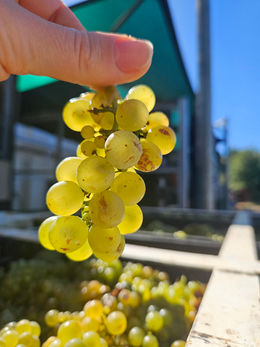
GOOD HOPE
SOUTHERN TIP OF AFRICA
Transport your imagination to vineyards framed by ancient mountains, just a stone's throw from the sea near the Cape of Good Hope.
When I first traveled to the Cape 10 years ago, I felt in love with the country and its wines. I also discovered the beautiful and rich biodiversity of the Cape, known as fynbos. I knew that I would do something with it sooner or later.
And in 2021, my wines of South Arica "Born of Fire" came to life, crafted in harmony with the principles of sustainable agriculture.

INSPIRATION
THE NAME
"Born of Fire is a tribute to the Cape Floral Kingdom.
Nature is an endless source of inspiration"
The Cape Floral Kingdom is the home to thousands of plant species unique to South Africa, the vegetation is composed of fynbos (Cape “fine Bush”). Fire is necessary for many fynbos plants, such as proteas, to release and activate seeds. Born of Fire, new flowers grow, ensuring propagation and survival.

CHENIN BLANC
W.O. SWARTLAND
BORN OF FIRE: Born of Fire is a tribute to the Cape Floral Kingdom. Nature is an endless source of inspiration. The Cape Floral Kingdom is the home to thousands of plant species unique to South Africa, the vegetation is composed of fynbos (Cape “fine Bush”). Fire is necessary for many fynbos plants, such as proteas, to release and activate seeds. Born of Fire, new flowers grow, ensuring propagation and survival.
SWARTLAND: (Dutch for 'black land') is named for the native renosterbos (rhinoceros bush) that turns black after rain
SOIL: Malmesbury Shale, a sedimentary rock found in South Africa's Western Cape, is part of the 600-million-year-old Malmesbury Group, consisting of shale, phyllite, and schist. It is named for the town of Malmesbury that sits in the middle of the region.
VINEYARD: While these soils are well drained, they also hold enough water in their lower reaches to support the irrigation-free farming technique. Bush vines will dig especially deep to get to the water reserves in the soil, resulting in stronger vines.
WINEMAKING: The grapes are hand-picked at the coolest time of the day. After a gentle pressing and a settling stage, the juice is transferred to 300-liter barrels and tanks. The use of 300L barrels allows the wine to develop complexity and refined aromas. The goal is to preserve the wine’s sense of place as much as possible.
AGEING: 7 months in barrels and tank.
TASTING: A fabulous white wine, showing mango, papaya and dried-lemon character with stony and floral notes. Deep and complex palate with wonderful tension between the tropical fruit, the spicy oak and a peppery quality. The long finish is both bright and creamy.
WINE & FOOD: As an aperitif with prawns, fish terrine, seafood salad, marinated raw fish, sushi, steamed fish, snails in garlic, spaghetti with clams, veal stew with tarragon, fresh or hot goats cheese.

SYRAH
W.O. SWARTLAND
BORN OF FIRE: Born of Fire is a tribute to the Cape Floral Kingdom. Nature is an endless source of inspiration. The Cape Floral Kingdom is the home to thousands of plant species unique to South Africa, the vegetation is composed of fynbos (Cape “fine Bush”). Fire is necessary for many fynbos plants, such as proteas, to release and activate seeds. Born of Fire, new flowers grow, ensuring propagation and survival.
SWARTLAND: (Dutch for 'black land') is named for the native renosterbos (rhinoceros bush) that turns black after rain
SOIL: Malmesbury Shale, a sedimentary rock found in South Africa's Western Cape, is part of the 600-million-year-old Malmesbury Group, consisting of shale, phyllite, and schist. It is named for the town of Malmesbury that sits in the middle of the region.
VINEYARD: While these soils are well drained, they also hold enough water in their lower reaches to support the irrigation-free farming technique. Bush vines will dig especially deep to get to the water reserves in the soil, resulting in stronger vines
WINEMAKING: The grapes are picked by hand at the coolest time of the day. After 3 weeks of maceration & wild fermentation, the wine goes to 300 litres barrels. The use of 300L barrels allows the wine to develop complexity and refined aromas. The goal is to preserve the wine’s sense of place as much as possible.
AGEING: 12 months in barrels
TASTING: Very complex, rich, red to dark fruit and plenty of very fine, sweet-scented spice, as well as a red floral edge and a thread of dried herbs and fresh earth. The palate has a powerful, layered, long and symphonic feel and is packed with rich red-plum and black-cherry flavor. Dark chocolate, black cherry, dark plum and more.
WINE & FOOD: To serve with chicken wrapped in bacon and cheese, bacon salad, duck salad, duck in plum sauce, grilled lamb, and cheeses such as Brie or Camembert.














